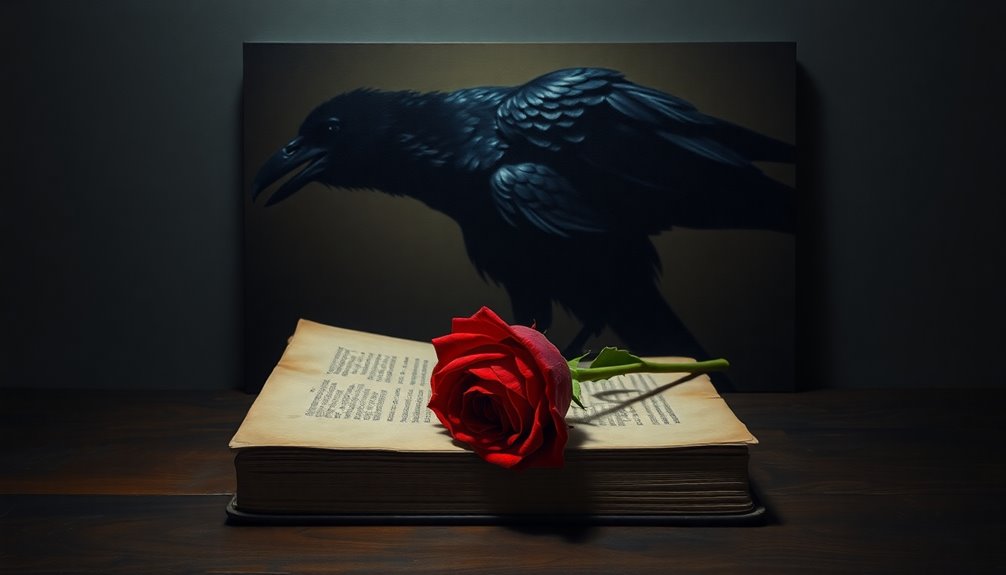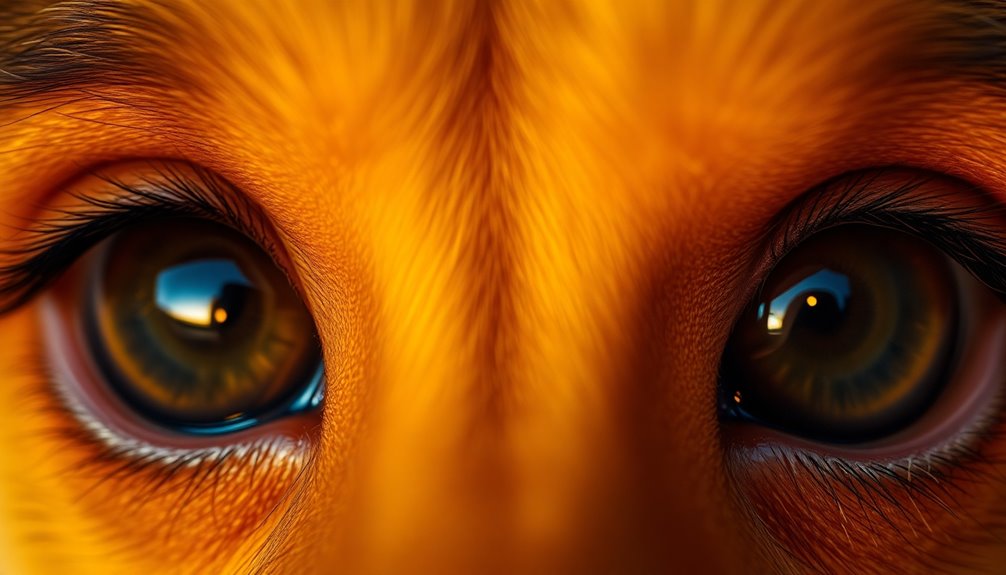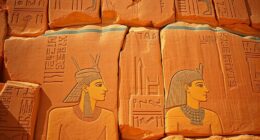Symbolism in art lets you uncover exciting, deeper meanings behind everyday images. Artists use symbols, like roses for love or skulls for death, to connect emotionally with viewers, making art feel personal and important. By employing vibrant colors and familiar shapes, they can express complex feelings and ideas. You might see blue representing calmness or dark shades for sadness. Each symbol can stir different emotions, encouraging you to explore your thoughts while looking at the artwork. This journey transforms viewing into an adventure, revealing more than what meets the eye. Keep exploring, and you'll discover even more about this enthralling subject!
Key Takeaways
- Symbolism conveys complex emotions and ideas through familiar symbols, enhancing viewer engagement and understanding of the artwork.
- Color symbolism can evoke specific feelings, such as using blue for calmness or dark hues for sadness.
- Simplified forms and vibrant colors clarify themes and enhance the emotional experience for the viewer.
- Incorporating mythological and literary references deepens thematic exploration and enriches the artwork's meaning.
- Engaging with personal and cultural symbols fosters empathy and connection, inviting viewers to explore their own emotions and experiences.
Understanding Symbolism in Art
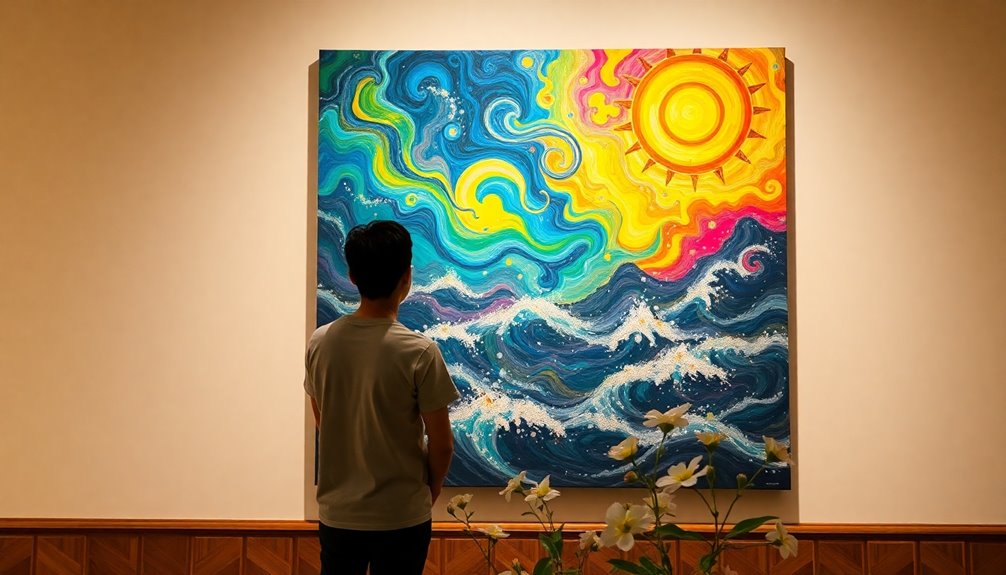
Symbolism in art is a powerful tool that lets artists convey deeper meanings beyond what you see on the surface. When you look at a painting or sculpture, you might notice symbols in art that represent big ideas, like love, death, or hope. For example, a rose often symbolizes love, while a skull can represent death. These symbols have a special, symbolic value that adds layers to the artwork's message.
Understanding symbolism is like solving a fun puzzle! The more you know about these symbols, the more you can appreciate what the artist is saying. Each artist might use personal or cultural symbols, making their work unique and special.
It's exciting to discover how these symbols connect to the artist's life or beliefs. Your own experiences and knowledge play a big role, too! If you recognize a symbol, it can help you feel a stronger connection to the art. This familiarity transforms your viewing experience into an enriching exploration.
Historical Context of Symbolism

Often rooted in the cultural shifts of the late 19th century, the historical context of symbolism reveals a reaction against the rationalism and materialism that dominated Western European society. This movement began in France during the 1880s, sparked by artists and writers who wanted to express deeper emotions and ideas. They believed that art should go beyond what you see and tap into feelings and thoughts.
One of the key moments in this movement was the Symbolist Manifesto, published by Jean Moréas in 1886. This document helped define symbolism and highlighted important figures like Charles Baudelaire, Stéphane Mallarmé, and Paul Verlaine. These symbolist artists often used symbols to convey complex themes, weaving stories filled with emotion and abstract ideas. Their works reflected a sense of pessimism and disillusionment, themes that many people felt during that time.
Influenced by Romanticism and Impressionism, symbolists aimed to share their personal experiences and connect with others on a deeper level. Philosophers like Schopenhauer inspired them to seek escape from the pain of the physical world through art.
This rich historical backdrop set the stage for the vibrant world of symbolism in art!
Key Techniques in Symbolic Art
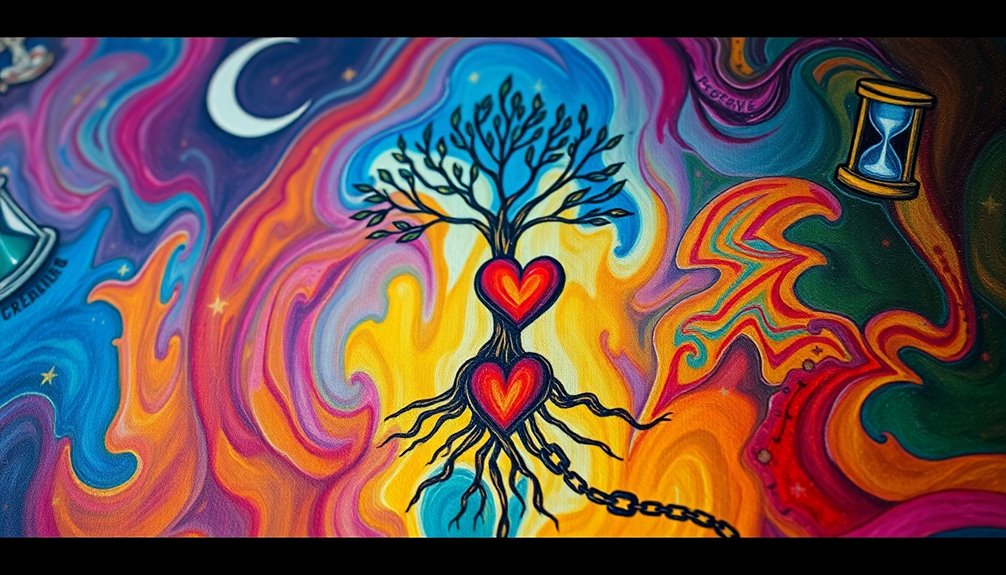
Several key techniques define the domain of symbolic art, enhancing the emotional and intellectual engagement of viewers. One exciting technique is the use of metaphor. Artists often represent complex ideas through familiar symbols, allowing you to connect deeply with the artwork. For instance, a dove might symbolize peace, while a skull could represent mortality.
Another important aspect is color symbolism. Different colors can express different emotions. For example, blue often represents calmness, while red can signify passion or anger. When you look at a painting, pay attention to the colors used; they can tell you a lot about what the artist wants you to feel.
Additionally, some artists blend sensory experiences, like in the concept of synesthesia. This means you might see colors that remind you of sounds or feelings. It creates a richer experience for you as a viewer.
Finally, incorporating mythological or literary references invites you to explore deeper themes presented in the artwork. So, as you enjoy symbolic art, remember to look for these techniques—they can transform your understanding and appreciation of what you see!
Impact on Viewers and Interpretation

When you look at symbolic art, it's like stepping into a world where every color and brushstroke tells a story.
This emotional connection can transform your viewing experience, making you feel joy, sadness, or even curiosity.
Emotional Resonance in Art
Exploring the emotional resonance in art reveals how symbolism can deeply impact viewers and their interpretations. When you look at art filled with symbols, you might feel a connection that goes beyond what you see. It's like a secret language! Artists use colors and shapes to express feelings. For example, darker colors might make you feel sad, while bright colors can bring joy.
Here's a fun way to think about it:
| Color | Emotion |
|---|---|
| Dark Blue | Sadness |
| Bright Yellow | Happiness |
| Deep Red | Passion |
| Soft Green | Calmness |
The beauty of symbolism in art is that it's intensely personal. Your background and experiences shape how you interpret these symbols. This means that every person might see something different, creating a rich tapestry of meanings!
As you engage with these symbols, you're invited to explore your own emotions. This journey can be exciting and rewarding, allowing you to feel empathy, nostalgia, or inspiration. Art becomes a shared experience, connecting you with others in wonderful ways!
Transformative Viewing Experiences
Art can transform your viewing experience from simple observation to deep emotional engagement, especially when it's rich with symbolism.
When you look at a piece filled with symbols, it's like opening a treasure chest of feelings and ideas. These symbols can pull you in, making you think and feel in ways you mightn't expect.
Here are some ways symbols can enhance your emotional experience:
- Evokes Feelings: Symbols can bring out emotions like love, joy, or even sadness.
- Personal Connection: You might find a deeper link to the artwork and its message.
- Encourages Reflection: Symbols invite you to think about your own experiences and beliefs.
- Enhanced Understanding: Recognizing symbols can boost your appreciation of what you're seeing.
- Mindset Shift: Art with symbolism can change how you view the world around you.
Creating Personal Symbols in Art
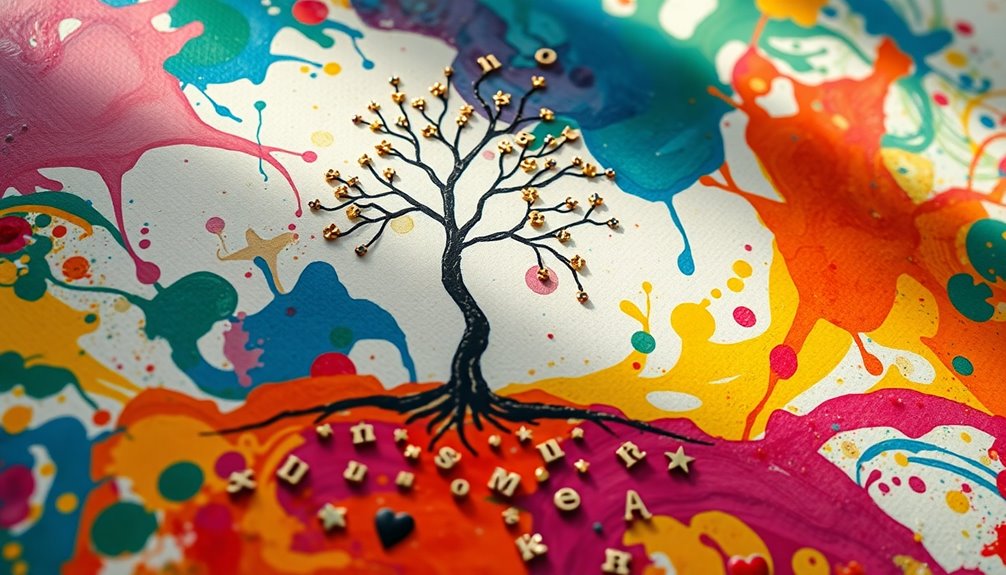
Creating personal symbols in art is a powerful way to express your unique experiences and emotions. You can start by thinking about what colors and shapes mean to you. Each color can have different emotional significance. For instance, blue might feel calm, while red could represent passion. By using these personal symbols, you can convey messages that truly reflect who you are.
As you create, dig deep into your memories and feelings. This reflection helps you develop original symbols that resonate with your audience. When you tell a story through your art, integrating these symbols creates a visual narrative that captivates viewers. They'll find deeper meaning in your work!
It's also important to be clear in your expression. You want your audience to understand your message without confusion. Balance complexity with accessibility, so your symbols shine brightly.
Plus, don't hesitate to seek feedback from friends or fellow artists. They can offer fresh perspectives and help refine your personal symbols, strengthening your artistic voice.
Prominent Artists and Their Symbols
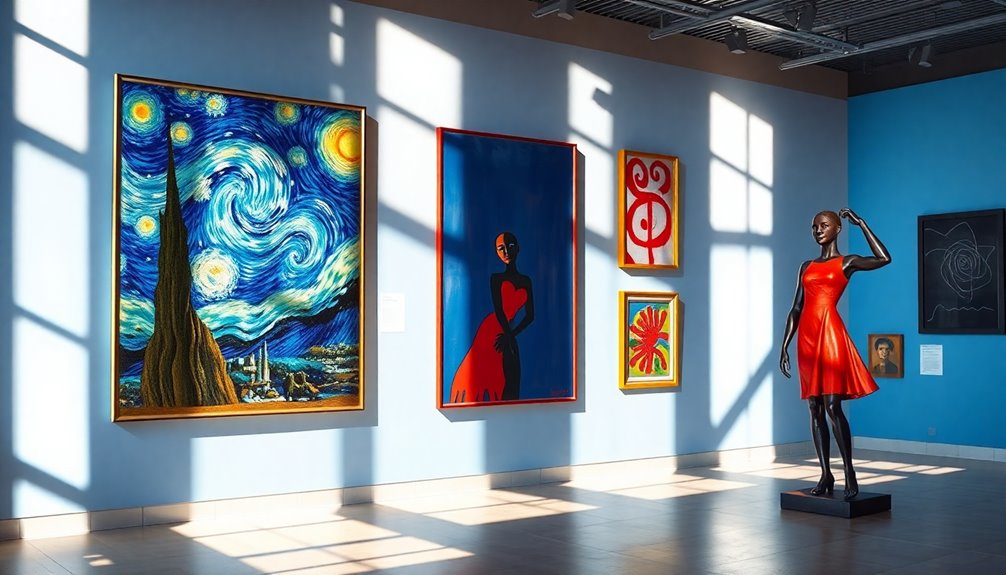
Let's explore how some famous artists use symbols in their art!
Each one has unique icons that help tell their stories, like Gustave Moreau's mythological themes or Edvard Munch's powerful emotions.
You'll see how these symbols connect to big ideas about life, dreams, and feelings, making art even more fascinating!
Symbolic Meanings in Art
Throughout history, artists have infused their works with rich symbolism, allowing viewers to engage with deeper meanings and emotions. Many prominent artists used symbolic meanings to express complex ideas. By exploring their unique styles, you can uncover fascinating interpretations!
Here are some notable examples:
- Gustave Moreau often used mythological subjects, like the sphinx, to represent mystery and the unknown.
- Odilon Redon created dreamlike images where flowers symbolized spirituality and the subconscious.
- Paul Gauguin's "Vision of the Sermon" used vibrant colors and shapes to symbolize the struggle between good and evil.
- Edvard Munch's iconic piece, "The Scream," featured a scream that represented existential anxiety and emotional turmoil.
- Henri Rousseau's naïve art style included jungles and exotic animals, showing his fascination with the unknown and nature's primal aspects.
These artists embraced a symbolist style that invites you to think beyond the surface.
When you look at art, remember that every color, shape, and object can tell a story!
Artists and Their Icons
Art is a visual language, and many artists have developed distinctive symbols that convey their unique perspectives and emotions. For example, Gustave Moreau often used mythical figures like the Sphinx and the Lion to share deeper meanings. These symbols represent mystery and power, inviting you to explore their hidden messages.
Odilon Redon took a different approach. His dreamlike imagery, featuring floating flowers and mysterious figures, symbolizes the subconscious. When you look at his art, you're encouraged to plunge into your own feelings and imagination. It's like peering into a dream!
Then there's Paul Gauguin, who used vibrant colors and simplified forms in works like "Vision of the Sermon." Here, he illustrates the fight between Jacob and the angel, showing spirituality and the duality of existence. This blend of color and form makes you think about life's big questions.
These artists, with their unique symbols, help you see the world in new ways. Each piece is a doorway into their thoughts and feelings, making art a shared journey of discovery.
Resources for Further Exploration

When exploring symbolism in your artwork, a variety of resources can enhance your understanding and application of these powerful visual elements.
You'll discover that these tools not only inspire you but also deepen your connection to art for art's sake.
Here are some great resources to contemplate:
- Becoming a Professional Artist: 11 Tips for Getting Your Art Into Galleries: This article offers advice on presenting artwork that uses symbolism effectively, emphasizing the importance of a unique value proposition to attract attention. Additionally, developing your cultural intelligence can help you better understand the symbolism that resonates across different audiences.
- 3 Revolutionary Steps to Create Atmosphere in Your Paintings: Learn techniques that enhance the emotional depth of the symbols in your art, as emotional branding strategies can significantly increase audience engagement. Additionally, consider how music therapy can evoke emotions that may influence your symbolic choices.
- 3 Ways That Tech Makes Online Art Ed Better Than In-Person Classes: Explore digital resources that can help you understand and apply symbolism.
- Milan Art Institute: Check out their programs focusing on skill development with symbolism in various art forms.
- Networking Platforms: Join organizations that connect you with other artists for feedback and inspiration on using symbols in your artwork.
- Engaging with market research can help you identify the types of symbolism that resonate with contemporary audiences.
Frequently Asked Questions
Which Is an Example of a Symbol in Art?
One great example of a symbol in art is the lion. When you see a lion, it often represents courage and strength.
Artists use this powerful animal to convey deep meanings about leadership and bravery. You might notice lions in paintings, sculptures, or even in stories.
Their majestic presence reminds us to be bold and confident. So next time you spot a lion in art, think about the strong messages it shares!
How Is Symbolism Used Effectively?
Symbolism's like a treasure map! It leads you to deeper meanings in art. To use it effectively, think about familiar symbols that everyone understands. A heart can show love, while a tree might represent life.
Clarity matters, so make sure your symbols are easy to recognize. Don't forget to ask friends for their thoughts! Their feedback can spark new ideas and help your artwork connect with even more people, making it truly special.
What Are the Main Features of Symbolism in Art?
The main features of symbolism in art include the use of vibrant colors and abstract forms.
These elements help create feelings and convey deeper meanings. Artists often focus on dreams, the subconscious, and mythological themes, inviting you to explore complex ideas.
Instead of showing things as they are, they express emotions and thoughts through imaginative visuals.
This unique approach allows you to connect with the artwork on a more personal level, sparking your imagination!
What Is Symbolic Expression in Art?
Symbolic expression in art is all about using images and ideas to share deeper meanings.
When you look at a piece, you might see a rose that stands for love or a skull that represents death. Artists use colors, shapes, and designs to make these symbols even more powerful.
This way, you get to explore your feelings and thoughts, turning every artwork into a fun adventure to find hidden messages and connections!
Conclusion
Symbolism in art is like a treasure hunt! When you spot a symbol, you uncover deeper meanings. Did you know that about 70% of people say art makes them feel happier? That's pretty cool! By using symbols, artists connect with us in special ways, making us think and feel. So, whether you're creating your own art or enjoying someone else's, remember to look for those hidden messages. Immerse yourself in the world of symbols and let your imagination soar!

